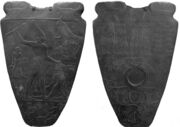31st century BC
Topic: History
 From HandWiki - Reading time: 2 min
From HandWiki - Reading time: 2 min
The 31st century BC was a century that lasted from the year 3100 BC to 3001 BC.
Events
- c. 3100 BC: Polo (Meitei: Sagol Kangjei[lower-alpha 1]) was first played in Manipur state.[lower-alpha 2][2][3]
- c. 3100 BC?: The Anu Ziggurat and White Temple are built in Uruk.
- c. 3100 BC?: Predynastic period (Neolithic) ends in Ancient Egypt.
- c. 3100 BC?: Early Dynastic (Archaic) period starts in Ancient Egypt.
- c. 3100 BC?: The first temple of Tarxien is in use by the Neolithic inhabitants of Malta.[4]
- c. 3100 BC?: First stage in the construction of Stonehenge.[5]
- c. 3100 BC: Oldest adobe building in the Americas was built in Peru.
- c. 3100 BC – 2600 BC: Skara Brae, Orkney Islands, Scotland is inhabited.[6]
- c. 3090 BC: Narmer (Menes) unifies Upper and Lower Egypt into one country; he rules this new country from Memphis.
- c. 3051 BC: The oldest currently living organism, a Great Basin bristlecone pine, undergoes germination in the White Mountains of California.
Inventions, discoveries, introductions
- Drainage and sewage system in the Indus Valley
- Dams, canals, stone sculptures using inclined plane and lever in Sumer and the Tigris–Euphrates Valley
- Copper was in use, both as tools and weapons.
- Senet is one of the oldest-known board games in the world.
- c. 3100 BC – Invention of writing in Mesopotamia and Egypt
- The Sydney rock engravings date to around 3000 BC (Sydney, Australia ).[7]
Notes
References
- ↑ Thokchom, Khelen (2003-11-28). "Italian seal on Manipur polo origin - Milan-based writer to visit Imphal to collect material for book on game's history". https://www.telegraphindia.com/north-east/italian-seal-on-manipur-polo-origin-milan-based-writer-to-visit-imphal-to-collect-material-for-book-on-game-s-history/cid/791135.
- ↑ McFarlan, Donald; McWhirter, Norris (1991) (in en). Guinness Book of World Records (1991). Bantam Books. pp. 706. ISBN 978-0-553-28954-1. "Polo can be traced to origins in Manipur state c. 3100 B.C., when it was played as Sagol Kangjei. Other claims are of it being of Persian origin, having been played as pulu c. 525 B.C."
- ↑ "Guinness Book of World Records 1991 says "Polo can be traced to origins in Manipur state c. 3100 B.C., when it was played as Sagol Kangjei" – SportsTract" (in en-US). https://sportstract.com/guinness-book-of-world-records-1991-says-polo-can-be-traced-to-origins-in-manipur-state-c-3100-b-c-when-it-was-played-as-sagol-kangjei/.
- ↑ Cilia, Daniel (April 8, 2004). "Tarxien". The Megalithic temples of Malta. http://web.infinito.it/utenti/m/malta_mega_temples/tarxien/tarxien.html. Retrieved on 2007-07-07.
- ↑ "FACTBOX - Stonehenge hosts Summer solstice revellers". Reuters India. June 20, 2010. http://in.reuters.com/article/idINIndia-49464120100620.
- ↑ Ring, Trudy; Watson, Noelle; Schellinger, Paul (28 October 2013). Northern Europe: International Dictionary of Historic Places. Routledge. p. 686. ISBN 978-1-136-63944-9. https://books.google.com/books?id=yfPYAQAAQBAJ&pg=PA686.
- ↑ "Australia’s top 7 Aboriginal rock art sites". March 30, 2016. https://www.australiangeographic.com.au/topics/history-culture/2016/03/top-7-aboriginal-rock-art-sites.
 |
Licensed under CC BY-SA 3.0 | Source: https://handwiki.org/wiki/History:31st_century_BC22 views | Status: cached on July 25 2024 13:06:35↧ Download this article as ZWI file
 KSF
KSF

